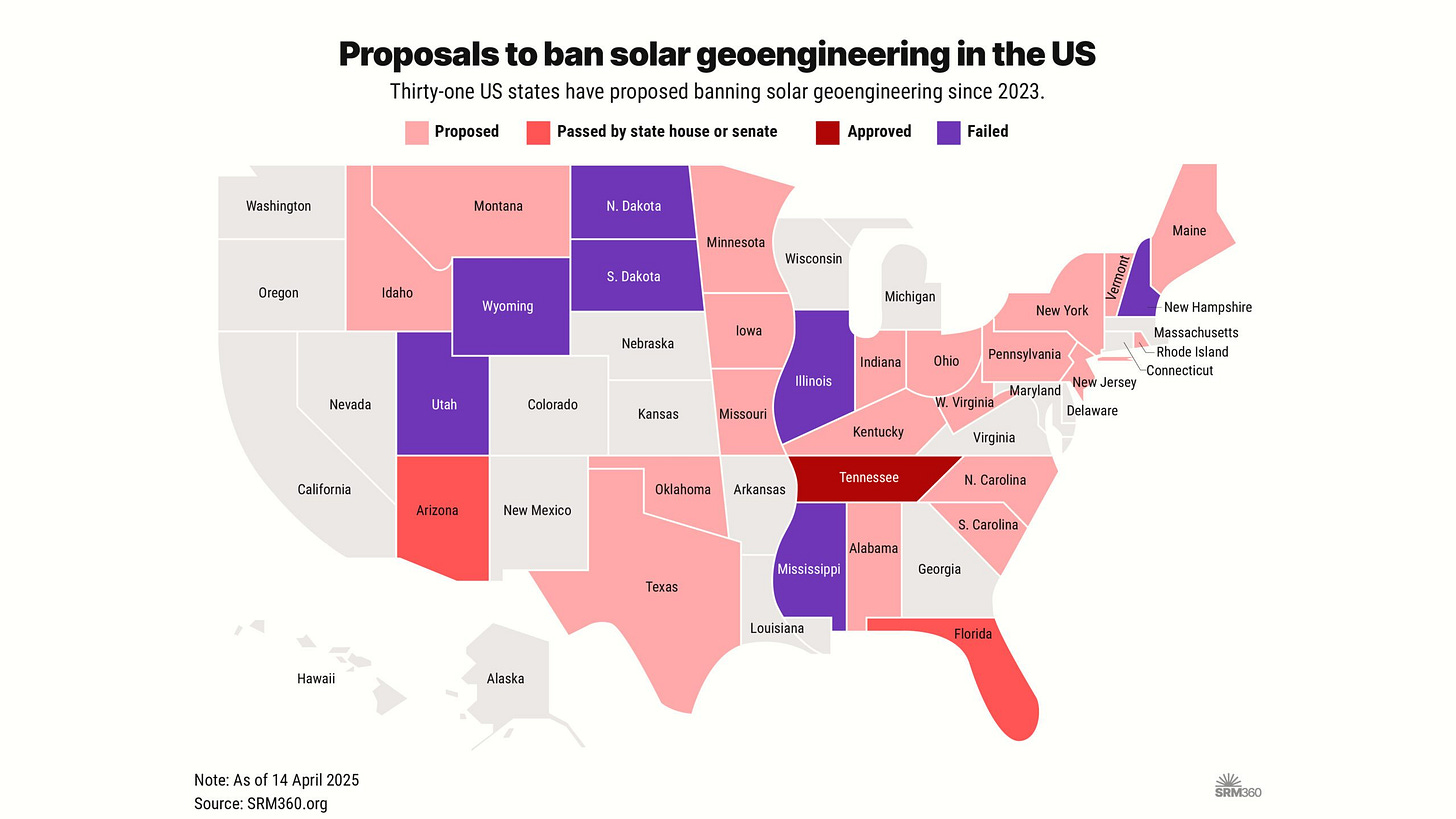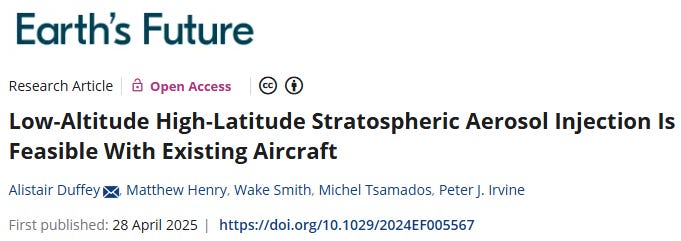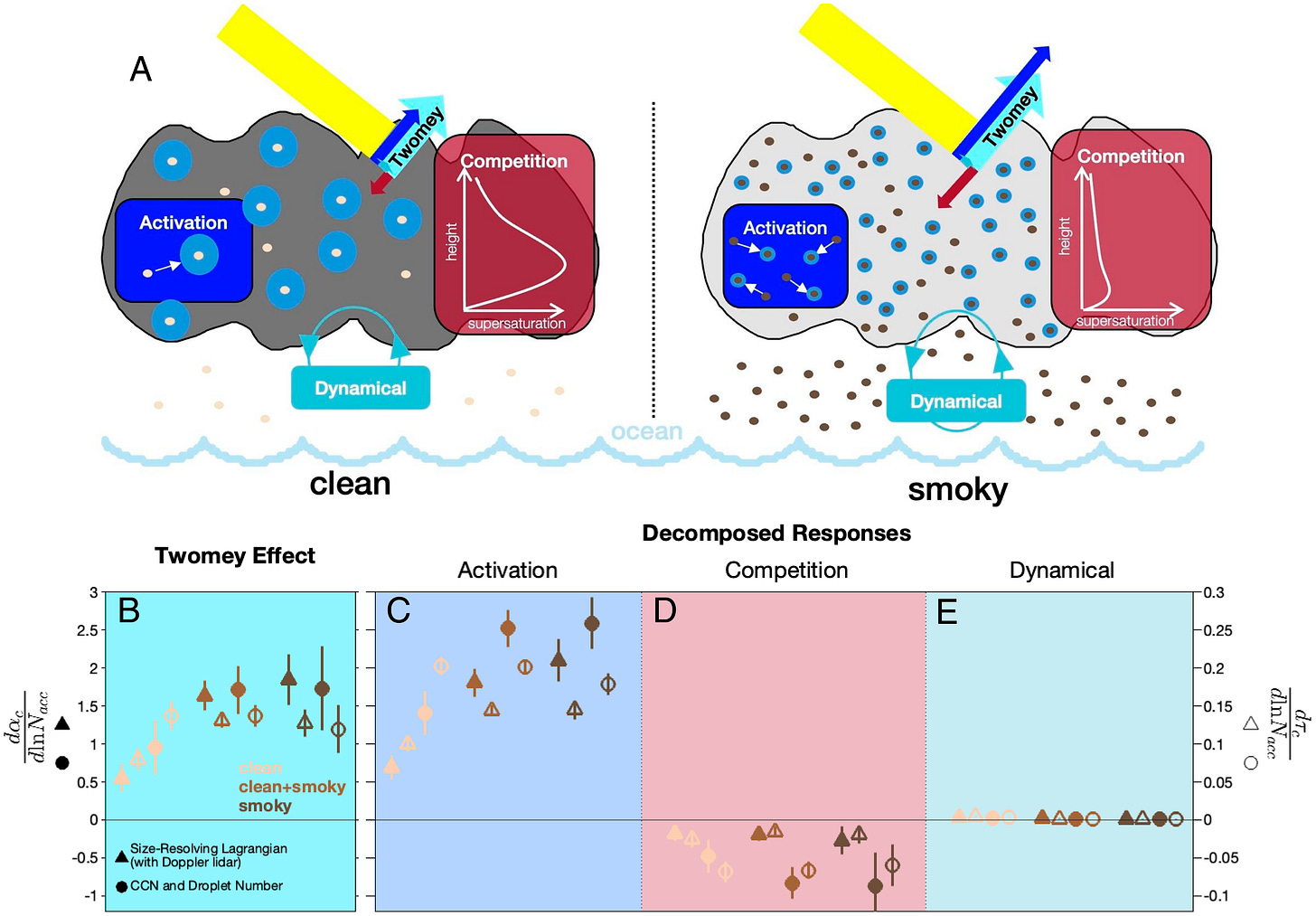Monthly Solar Geoengineering Updates (April'2025)
Links to recent scientific papers, web posts, upcoming events, job opportunities, podcasts, and event recordings, etc. on Solar Geoengineering (SRM)
TOP 10 SRM HIGHLIGHTS FROM APRIL’2025
SRM OUTDOOR RESEARCH: UK scientists are set to begin outdoor geoengineering experiments as part of a £50 million government-funded programme. Backed by the Advanced Research and Invention Agency (Aria), the small-scale trials will be rigorously assessed and are expected to provide critical data on the potential of solar geoengineering. Combined with an additional £11 million initiative, the programme positions the UK among the world’s leading funders of geoengineering research. Full project details are expected in the coming weeks.
SRM RESEARCH FUNDING: UK Research and Innovation’s National Environment Research Council (NERC) is investing £10 million in four new research projects under a 5-year programme—Modelling Environmental Responses to Solar Radiation Management—to explore the risks, limitations, and trade-offs of SRM.
SRM PROJECT: The Navigate project, launched in April 2025 by researchers from NORCE & BCCR, CICERO, and the Norwegian Meteorological Institute, will examine the climate system’s response to CDR and SRM. Key questions include how much carbon must be removed to limit global warming and whether solar radiation can be managed to alter the Earth's energy balance.
REPORT: The German Environment Agency (UBA) has released a report on SRM, calling for a non-use agreement to prevent its development and deployment, warning that outdoor experiments could create a path dependency toward normalization. The report calls for global governance to regulate research, ensure funding transparency, and prevent unilateral action. Read DSG’s response to the report here.
REQUEST FOR PROPOSALS: Reflective is seeking proposals to evaluate the impacts of a theoretical high-latitude/low-altitude SAI deployment, and to assess the tradeoffs between this approach and potential other strategies. Up to $100K per project, with $400K total funding available. Apply by June 9, 2025. Reviewer nominations are also open for those not applying.
DEMAND FOR INFORMATION: The U.S. EPA has issued a formal information request to Make Sunsets, which has launched over 120 SO₂-filled balloons into the atmosphere since 2022 as part of a private geoengineering effort intended to cool the planet & generate climate “cooling” credits for sale. The EPA’s Office of Air & Radiation submitted the demand under Section 114 of the Clean Air Act, which authorizes the agency to obtain detailed information from entities about their emissions & operations. Read the response from the Make Sunsets co-founder & other geoengineering experts on this news here.
PROPOSED BANS ON SRM: Dozens of bills aiming to ban solar geoengineering have been introduced in U.S. state legislatures. More than 30 states have seen such proposals, but only Tennessee has enacted one into law. Similar bills have passed one legislative chamber in Arizona and Florida, failed in eight states, and remain under consideration in the others. Read expert reactions to the proposed solar geoengineering bans—and what they could mean for the future of SRM research—here.
OPINION PIECE BY SIR DAVID KING: In a Guardian op-ed titled We passed the 1.5C climate threshold. We must now explore extreme options, Professor Sir David King, head of the Climate Crisis Advisory Group, writes: “We do not have the luxury of rejecting solutions [geoengineering technologies] outright before we have thoroughly investigated their risks, trade-offs and feasibility.”
RESEARCH STUDY: A new modeling study led by UCL researchers suggests that stratospheric aerosol injection could be achieved using existing large commercial aircraft like the Boeing 777F. The study found that injecting particles 13km (low altitude) above the poles could still cool the planet, though less effectively than at higher altitudes (above 20km) near the equator—and may require 3x more aerosols and pose greater acid rain risks.
UPCOMING EVENT: The 2025 Degrees Global Forum, the largest conference to date on SRM, is taking place from 12–16 May 2025 in Cape Town, South Africa. The event will bring together researchers, NGO representatives, policymakers, thought leaders, and journalists from around the world to discuss the scientific, social, and political dimensions of SRM. GeoMIP will also be convening for their 15th annual workshop during the Degrees Global Forum on Friday, 16 May 2025.
For a full recap of last month’s updates, check out our weekly summaries: WEEK 1 | WEEK 2 | WEEK 3 | WEEK 4 | WEEK 5
And here’s a quick overview:
RESEARCH PAPERS
Regional Climate Impacts of SRM
Several new studies shed light on how SRM could reshape regional climates. In Southeast Asia, SRM appears to ease extreme rainfall. In Thailand, sea level rise projections fall under SRM, particularly with G6sulfur, though seasonal monsoon-linked patterns persist. Similarly, in Eastern Indonesia, tropical cyclone rainfall is reduced under SRM, but cloud-aerosol uncertainties remain. Over in Eastern Africa, SAI reduces warming but brings mixed rainfall responses, highlighting regional complexities that call for scenario-specific research.
Technology, Trials & Tools
Progress continues on the technical front. A first-generation marine cloud brightening trial off the Great Barrier Reef confirms that sea salt aerosols can reach cloud base—a key feasibility milestone for MCB. In space, researchers have outlined a multi-phase roadmap for a planetary sunshade system, pushing solar geoengineering into sci-fi-turned-policy territory. Reinforcement learning is now being tested to optimize SAI deployment, with promising early results, while the SAI Simulator, a new open-source web tool, lets anyone explore climate scenarios online.
Who Governs SRM—and Who Could Deploy It?
A recent paper reviews the governance history of SRM from 2006 to 2024, challenging the view of SRM as an ungoverned space. It reveals a complex landscape of initiatives, mostly led by Global North countries with concentrated research and governance capacity. A provocative study on deployment capacity argues only a few states—notably the US and China—could unilaterally implement full-scale SAI, bringing geopolitics to the fore.
Aerosol Science & Modeling Challenges
Aerosol-cloud interactions continue to challenge modelers. New research shows how aerosol crowding in the tropical Atlantic weakens the Twomey effect, a key cloud brightening mechanism, underscoring the limits of current climate models and the need for refined aerosol dynamics to ensure accurate SRM projections.
WEB POSTS AND REPORTS
SRM Governance and Political Debates
Web posts from the past month show growing tension in SRM governance and political debates. A recent SRM360 piece finds broad overlap in informal SRM governance principles but says formal laws and rules are still a long way off. Meanwhile, DSG’s response to the German UBA report critiques the limits of prohibition-based governance. On the global stage, Project Syndicate emphasizes the need for African leadership in shaping governance frameworks.
Technical and Deployment Front
On the technical and deployment front, there’s increasing evidence that solar geoengineering is no longer a hypothetical. Studies reported by The Telegraph and Phys.org suggest that SAI could be executed with today’s aircraft. In the UK, geoengineering experiments are advancing: The Guardian and The Telegraph both report that government-backed outdoor trials could begin within weeks. This has drawn both support and skepticism—Research Professional News calls the trials a “missing part” of climate science, while Science News notes the broader shift as SRM moves into the mainstream.
Tension and Momentum Around SRM in the U.S.
At the same time, public engagement and state-level resistance are reshaping the landscape. Several U.S. states are actively considering restrictions: Texas and Florida advanced legislation to ban geoengineering, while Utah passed cloud seeding bills but rejected a ban. E&E News ties these moves to rising conspiracy theories. Meanwhile, the EPA has turned its attention to “Make Sunsets,” signaling a regulatory spotlight on commercial actors experimenting with SRM. Legal Planet tracks how the politics around geoengineering are becoming more unpredictable. In contrast, Indiana’s first-ever student-led Geoengineering Summit shows rising grassroots interest in this technology.
Strategic Reflection and Caution
Finally, a set of posts urge strategic reflection and caution. Bloomberg argues that the risks of geoengineering remain understudied, and critiques flashy ideas like orbital mirrors as distractions from real solutions. Meanwhile, the Council on Foreign Relations calls for “climate realism,” urging policymakers to strike a careful balance between innovation and risk. Furthermore, Co-Create in their new report outlines 5 Case Studies of potential field tests of SRM and related activities, including their technical and non-technical dimensions and implications.
PODCASTS AND VIDEOS
Solar geoengineering is showing up in big conversations—from geopolitics to public trust. On Reviewer 2 Does Geoengineering, Jeffrey Nielsen dives into the strategic tensions between the U.S. and China, exploring how SRM fits into their great-power rivalry. Science podcast explores the social hurdles researchers face when talking about climate engineering trials—from ocean CDR to sunlight reflection—and how to build public trust around them.
In a wide-ranging StarTalk Radio episode, Neil deGrasse Tyson, Holly Jean Buck, and Daniele Visioni explore whether building an atmospheric sunshade is bold climate action—or dangerous hubris. The ethical stakes of SRM are front and center: just because we can reflect sunlight, should we? Wicked Problems poses the same challenge with a sharper edge: is solar geoengineering “climate chemo” or the planet’s Ozempic? Harvard and UChicago researchers debate whether it’s time to break the glass or abandon the idea entirely. Furthermore, on Climate Reflections podcast, Daniele Visioni and Oliver Morton unpack the deep ties between SAI and air pollution.
The Co-CREATE Seminar examines how the precautionary principle applies to SRM, asking whether existing legal tools can guide future research. Meanwhile, SRM360 hosts a timely discussion on the surge in moratoria and proposed bans—especially across U.S. states—reflecting rising political tension, and on WePlanet’s Bad Ideas, Oliver Morton pushes back against the taboo, calling for open discussion before it’s too late.
In Climate Chat, Peter Irvine explains how solar geoengineering might reduce emissions and limit dangerous temperature overshoot, while Douglas MacMartin unpacks how SRM could prevent catastrophic AMOC collapse. TEDxBoston features Daniele Visioni making the case for serious research into sunlight reflection, asking what our future selves will wish we had known—and done—sooner. Furthermore, Christian Soschner interviews Janos Pasztor in a deep dive into the ethical and geopolitical risks of geoengineering, asking whether it's a lifeline or a ticking time bomb.
UPCOMING EVENTS, JOBS AND DEADLINES
Harvard University is hiring a Program Director for its Solar Geoengineering Research Program (SGRP), a leading interdisciplinary initiative focused on science, policy, and public understanding of SRM. While, Reflective is seeking proposals (deadline: 09 June) to evaluate the impacts of a theoretical high-latitude/low-altitude SAI deployment. RFF and Harvard SG Research Program is also inviting research proposals (deadline: 30 May) for the upcoming SRM Social Science Workshop.
May will be a major month for global solar geoengineering dialogue. From 12–16 May, Cape Town will host both the 2025 Degrees Global Forum and the 15th GeoMIP Workshop, bringing together scientists, policymakers, and civil society. As part of the Degrees forum, attendees can also catch a documentary screening of Plan C for Civilization on 13 May. Later in the month, UNEP will host a high-level consultative workshop and science-policy dialogue on SRM, held 19–20 May in Switzerland.
Looking ahead, The Transition Accelerator will hold an online panel discussion on 10 June titled “Can We Afford to Ignore Solar Geoengineering?”. June also brings the Arctic Repair Conference in Cambridge (26–28 June), organized by the University of Cambridge and the Centre for Climate Repair, which will explore polar interventions and extreme climate solutions.
The second half of 2025 features several key governance-focused gatherings. On 4–5 September, Resources for the Future (RFF) and Harvard will co-host a social science research workshop in Washington DC, examining SRM governance in a fractured global landscape. And in November, the World Meteorological Organization will hold the 11th Scientific Conference on Weather Modification in Pune, India (3–7 November), highlighting global progress on climate and atmospheric interventions.
All these events—and more—are listed in the Solar Geoengineering Events Calendar by Andrew Lockley, the go-to hub for tracking SRM activities worldwide.
You can directly sync all Solar Geoengineering events to your default calendars by pressing the link below:
Follow us on:
Twitter | Bluesky | YouTube | Substack | Google Group | Podcast 1 | Podcast 2


















